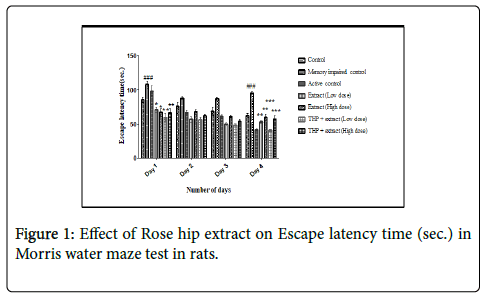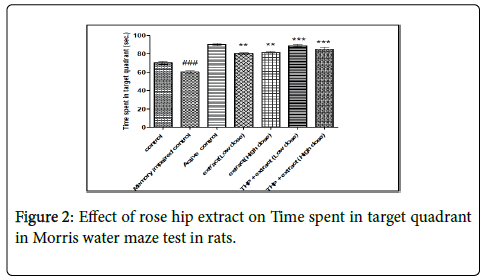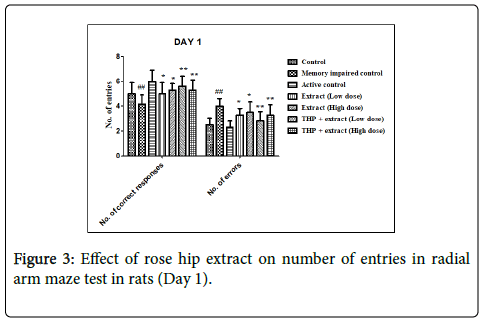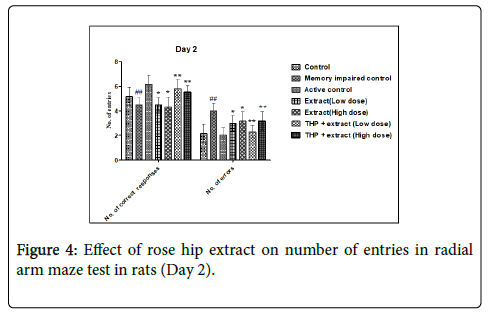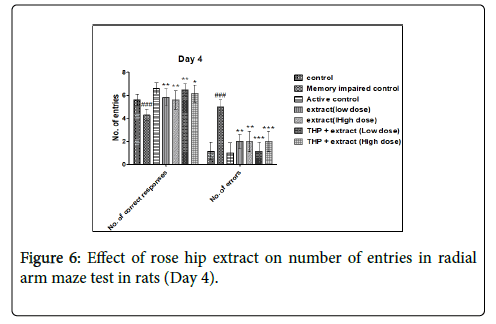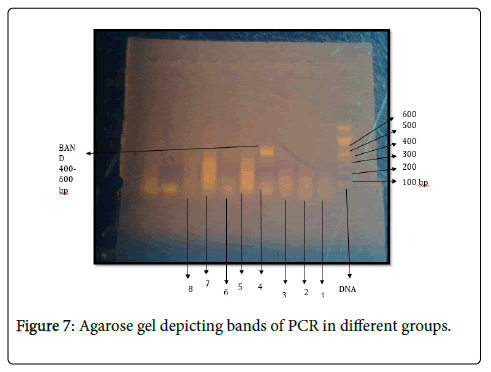Effect of Rose Hip Extract on Spatial Memory in Rats and Correlation with Hippocampal Expression of Phosphorylated Protein Kinase C
Received: 29-Apr-2020 / Accepted Date: 20-Jul-2020 / Published Date: 27-Jul-2020 DOI: 10.4172/2167-065X.1000200
Abstract
Search for newer plant derived medicinal is always on. Rose hip plant is the plant showing promising potential. Reverse pharmacology and transdisciplinary exploratory studies on rose hip are increasingly being studied these days. In this study seven group of animals were assessed with different dose levels were assessed for their effects on spatial memory by using Morris water maze and radial arm maze. A significant increase in TSTQ and decrease in escape latency time was observed in test groups as compared to memory impaired and control group. Also significant increased expression of protein kinase C was observed in test groups as compared to memory impaired group.
Keywords: Spatial memory; Radial arm maze; Morris water maze; Hippocampus; Reverse transcriptase polymerase chain reaction
Introduction
Spatial memory includes the ability to remember the spatial layout of environments, to know how to travel from one place to another, to remember the locations of objects, to know our own location in the environment, to have knowledge about the general geographic environment, and knowledge about spatial arrangements of objects. It is a complex multidimensional process which includes a variety of components that help us to orient and act in space [1]. The hippocampus has a major role in spatial memory and is involved in many functions of spatial memory [2,3]. A critical mass of evidence derived from anatomical and electrophysiological studies has pointed towards the enhancement of long term potentiation (LTP). The initiation and induction of LTP seems to depend on influx of calcium through the NMDA receptor-channel while the cell is depolarised through action of AMPA receptors. Apart from hippocampus, this may be found in dentate gyrus and other brain regions such as neocortex, limbic forebrain, and sympathetic ganglion. In the majority of studies, LTP has been reported at excitatory synapses.
Inspite of a widespread usage of herbals by indigenous practitioners it has always fallen short of global acceptance owing to the lack of standard protocols and reproducible product performance. Therefore to maximize their ultimate effect. We have to ensure that preparations derived from Rose hip are of acceptable quality, safety and efficacy. The adoption of multidisciplinary research strategies of rose hip should facilitate their rapid development, their more extensive public use quality, safety and efficacy. Thus it is hoped that assessment of these traditional remedies from rose hip could become the basis for a future classification of herbal medicines. Thus, the growing evidence base for rosehip suggests that this traditional herbal remedy has a high safety profile. Existing research (both in vitro and in vivo) suggests that rosehip may offer an effective therapy and is a viable replacement or supplement for conventional drug therapies such as NSAIDs in osteoarthritis and possibly other inflammatory diseases. This plant also found to have antioxidant activity while further research is required to establish its role for the treatment of various disorders [4].
Materials and Methods
Animals
Wistar albino rats (80 gm-110 gm body weight) of either sex were selected. The animals were housed in groups of five under standard laboratory conditions. Animals were fed on standard pellet diet and water made freely available. The animals were acclimatized to the environment for a week prior to the studies. All experiments were performed in the forenoon. The institutional animal ethical committee (Registration No. M.PH/IAEC/01/2012/ECC-2) approved the protocol. Experiments were performed in accordance with the guidelines of the institutional animal ethical committee.
Plant extracts
Rose hip was collected from horticulture department of Bangalore. The plant was authenticated by the taxonomist at Institute of wood sciences and technology, Bangalore. The voucher specimen no. is AR/ IWST/MISC/2013.Dried fruits (about 60 g) were extracted with 300 ml methanol and distilled water mixture (1:1) in a Soxhlet apparatus for 10 h. After extraction, the solvent was filtered and then the crude extracts thus obtained were dried to obtain thick viscous residues for further use. The dried extract was weighed and yield calculated. Dried extracts were stored in labelled glass bottles for further use.
Experimental design
Rats were grouped into 8 groups of 6 animals each. Group I animals served as control and received the vehicle only. Group II animals received Trihexyphenidyl (THP) (0.3 mg/kg), Group III Piracetam (200 mg/kg body weight i.p.). IV and V received low and high dose of rose hip extracts, group VI and VII received THP+low and high dose of extract.
Morris water maze test
Morris water-maze test (MWM) was employed to assess learning and memory of the animals. The first apparatus used to evaluate the spatial memory was a circular tank (100 cm diameter) filled with water to a depth of 30 cm. The medium was made opaque by adding milk to it. The tank was equally distributed into four points along the perimeter which served as starting locations. The tank was arbitrarily divided into four equal quadrants and a small platform (5 cm wide) was placed in the center of one of the quadrants. The water maze was always located in a large room with minimal disturbance and the observer always sat in the same position. Experiments were carried out between 9.00 to 12.00 am. During the training session the animals were released into the water and allowed 120 seconds to find the platform. Each animal received four trials on day one and subsequently eight trials per day for eight days. The trials sessions had a five minute inter trial interval. The test extracts were administered sixty minutes prior to the first trial daily. Twenty four hours after the last training trial the animals were subjected to spatial memory test whereby the time spent in the target quadrant was measured and taken as an indicator for spatial memory.
Radial arm maze test
The second apparatus was radial arm maze in which rats were placed on the centre hub with all guillotine doors lowered. Then, all the doors were simultaneously opened to allow the rat to choose arm freely .When the rat enters one of the arms, the doors to the remaining seven arms were closed. Open door was closed after the animal returns to the centre hub. The trial was considered complete when the rat visits all the eight arms or spend 10 min. in the maze. Entry into an arm which the rat had not previously visited was recorded as correct response and re-entry was counted as an error. A trial in which animal made no error, or only one error at the eigth choice was considered as “successful trial”.
Polymerase chain reaction
Hippocampal expression of protein kinase C was assessed by RTPCR in which total RNA of rat was isolated from hippocampus and reverse transcribed by using RNA Zol kit (sigma Aldrich). Primers were used to amplify the entire cDNA of the pkC gene: upstream and downstream respectively by using cDNA Amplification kit (Agilent technologies). Primers were designed from a previously published sequence. Amplified DNA was made to run on a 2.0% agarose gel in 1 X TAE (Tris- acetate/EDTA) buffer, stained with ethidium bromide, and photographed and correct size bands were excised from the gel.
Results
Morris water maze test
Values are expressed as mean ± SEM for six animals in each group. Two- way ANOVA followed by bonferroni test. P<0.05 was considered as statistically significant. ### P˂0.05 Vs control group; *** P˂0.05 Vs control group; *** P˂0.05 Vs active control group; *** P˂0.05 Vs memory impaired group (*P<0.05, ** P<0.01, ***P<0.001) (Figures 1-7).
Values are expressed as mean ± SEM for six animals in each group. One- way ANOVA followed by bonferroni test. P<0.05 was considered as statistically significant. ### P˂0.05 Vs control group; *** P˂0.05 Vs control group; *** P˂0.05 Vs active control group; *** P˂0.05 Vs memory impaired group (**P<0.01, ***P<0.001).
Values are expressed as mean ± SEM for six animals in each group. One-way ANOVA followed by bonferroni test. P<0.05 was considered as statistically significant. ### P˂0.05 Vs control group; *** P˂0.05 Vs control group; *** P˂0.05 Vs active control group; *** P˂0.05 Vs memory impaired group (**P<0.01, ***P<0.001).
Values are expressed as mean ± SEM for six animals in each group. One- way ANOVA followed by bonferroni test. P<0.05 was considered as statistically significant. ### P˂0.05 Vs control group; *** P˂0.05 Vs control group; *** P˂0.05 Vs active control group; *** P˂0.05 Vs memory impaired group (**P< 0.01, ***P<0.001).
Values are expressed as mean ± SEM for six animals in each group. One- way ANOVA followed by bonferroni test. P<0.05 was considered as statistically significant. ### P˂0.05 Vs control group; *** P˂0.05 Vs control group; *** P˂0.05 Vs active control group; *** P˂0.05 Vs memory impaired group (**P<0.01, ***P<0.001).
Values are expressed as mean ± SEM for six animals in each group. One- way ANOVA followed by bonferroni test. P<0.05 was considered as statistically significant. ### P˂0.05 Vs control group; *** P˂0.05 Vs control group; *** P˂0.05 Vs active control group; *** P˂0.05 Vs memory impaired group (**P< 0.01, ***P<0.001).
Assessment of hippocampal protein kinase expression by RTPCR
• Well A- Extract (Low dose): Less expression of protein
• Well B- Extract (Low dose): Moderate expression of protein
• Well C- THP+Extract (Low dose): Slightly increased expression of protein
• Well D- Memory impaired group: More expression of protein
• Well E- Standard group: Increased expression of protein
• Well F- THP+Extract (High dose):Slight expression of protein
• Well G- Control group: Slightly increased expression of protein For morris water maze
Above graphs shows decrease in escape latency time (ELT) during subsequent exposure to morris water maze, specifically significant decline on the day 4 as compared to day 1. A significant increase in ELT was observed in memory impaired group as compared to control group.
Significant decrease in ELT was also observed in test groups as compared to memory impaired, standard, and control group. However, administration of rose hip extract in diseased group was highly significant which indicates consolidation of memory.
A significant increase in time spent in target quadrant (TSTQ), on probe day (day 5) indicates retrieval of memory. Significant difference was found in test groups as compared to memory impaired, standard, and control group. Retrieval was highly significant in diseased group with rose hip extract [5].
Thus, it is evident that administration of rose hip extract significantly improved MWM performance by enhancing spatial working memory. It improves spatial performance by decreasing oxidative stress and neuronal susceptibility to excitotoxicity.
For radial arm maze
Spatial memory was also assessed by radial arm maze performance of rats. There was significant decrease in number of errors and increase in number of correct responses with increase in number of days. Significant difference was observed in memory impaired group as compared to control group. Also significant results were observed in test groups as compared to control group, active control group and memory impaired group. However highly significant results were observed in diseased group treated with rose hip extract [6].
Enhancement of spatial performance on radial arm maze was due to increase in hippocampal neurogenesis and prevention of hippocampal cell loss in rats.
By RT-PCR technique
PCR analysis depicted expression of protein in different groups. Slightly increased expression of protein was observed in different test groups, increased expression was observed in standard and control group, whereas more expression of protein was observed in memory impaired group in hippocampus of rats, which may have a significant effect on synaptic plasticity.
Discussion
In our study, we have found that the rose hip extract is effective in improving the performance of rats. As our experimental results shows a significant increase in time spent in target quadrant (TSTQ), on probe day (day 5), which indicates retrieval of memory on Morris water maze. Significant difference was found in test groups as compared to memory impaired, standard, and control group. Retrieval was highly significant in diseased group with rose hip extract. Similarly, a significant decrease in number of errors and increase in number of correct responses with increase in number of days was observed on radial arm maze. Also, highly significant results were observed in diseased group treated with rose hip extract.
After we not only limited our study to the performance of rats on various experimental models but also further studied the main cause of improvement in their memory. We studied the hippocampus expression of proteins genetically by Reverse transcriptase polymerase chain reaction technique. We concluded that when there is high expression of proteins in the memory impaired group then there performance is increased and mainly the expression of protein kinase C in hippocampus inproves spatial performance in rats.
However, from previous studies we have found that various plant extracts were only tested for their performance on various models or if there is hippocampal study of plant extracts then they do not conclude the expression of which protein is related to their improved performance [7]. Various previous studies have shown the improvement in memory of rats in hippocampus is due to various proteins but we have concluded from our study that the improvement in the memory of rats was due to slightly increased expression of protein kinase C.
Therefore, in our study we can conclude that extract of rose hip can be effective for more future studies related to other memories also. Because the plant rose hip extract is very effective in improving the spatial dmemory of rats and also proves it genetically by RT-PCR technique. Because it improves synaptic plasticity and reduces oxidative stress in animals.
Conclusion
Inspite of a widespread usage of herbals by indigenous practitioners it has always fallen short of global acceptance owing to the lack of standard protocols and reproducible product performance. Numerous traditional plants are underutilized for their medicinal value. One of such plant is rose hip which had shown promising spatial memory enhancement effect against in vivo and in vitro models on experimental animals. It has also shown effect on expression of protein in rat hippocampus which may be responsible for maintaining synaptic plasticity and long term potentiation.
Existing research (both in vitro and in vivo) suggests that rosehip may offer an effective therapy and can be a viable supplement for conventional drug therapies in spatial memory. While further research is required to establish its role in the enhancement of spatial memory.
References
- Postma A, Izendoorn R, DE Haan EHF (1998) Sex differences in object location memory. Brain and Cognition 36:334-345.
- Burgess N, Recce M, O’Keefe JA (1994) Model of hippocampal function. Neural Networks 7:1065-1081.
- Burgess N, Maguire EA, O’Keefe J (2002) The Human Hippocampus and Spatial and Episodic Memory. Neuron 35: 625-641.
- Gupta VK, Sharma SK (2006) Plants as natural antioxidants. Natural Product Radiance 5:326-334.
- Handa SS, Kapoor VK (2003) Textbook of Pharmacognosy. Second edition, India: Vallabh Prakashan.
- Kulkarni SK (2006) Handbook of experimental pharmacology. Vallabh Prakashan, New delhi 3:57-58.
- Vasudeva R, Kulkarni SK (2000) Possible antioxidant mechanism in melatonin reversal of aging and chronic ethanol-induced amnesia in plus-maze and passive avoidance memory tasks. Free Radical Biology & Medicine 30:595-602.
Citation: Mittal K (2020) Effect of Rose Hip Extract on Spatial Memory in Rats and Correlation with Hippocampal Expression of Phosphorylated Protein Kinase C. Clin Pharmacol Biopharm 9: 200. DOI: 10.4172/2167-065X.1000200
Copyright: © 2020 Mittal K. This is an open-access article distributed under the terms of the Creative Commons Attribution License, which permits unrestricted use, distribution, and reproduction in any medium, provided the original author and source are credited.
Select your language of interest to view the total content in your interested language
Share This Article
Recommended Journals
Open Access Journals
Article Tools
Article Usage
- Total views: 2656
- [From(publication date): 0-2020 - Oct 20, 2025]
- Breakdown by view type
- HTML page views: 1851
- PDF downloads: 805

